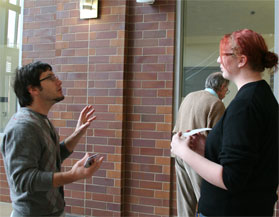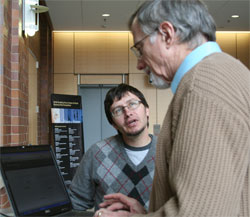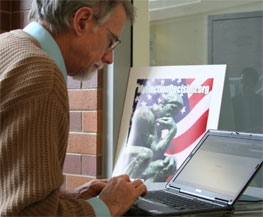Election Decision Web Site Debuts at Town Hall Meeting
By Anna Lynn Spitzer
|
Irvine, Calif., Jan. 28, 2008 -- About three weeks before Feb. 5, this year known as Super Tuesday – it’s the day on which 23 states will help choose this year’s presidential candidates – some California voters were introduced to a Web site that could effectively end their pre-primary indecisiveness.
MyElectionDecision.org made its Southern California public debut on Jan. 14 at UC Irvine’s Election 2008 Town Hall Meeting. The Calit2-sponsored site, which matches users with the presidential candidate whose views most closely resemble their own, establishes its matches based on users’ rankings of key issues and their answers to detailed questionnaires. The site was developed in an effort to learn whether technology can engage Generation Y more deeply in the political process.
“There is a lot of student apathy concerning the political process,” said Rob Beck, a Calit2@UCI researcher and one of the site’s creators. “We are trying to counter this indifference by reaching out to them online.”
Ted Gaulin, a political science graduate student who worked on the site, introduced it to more than 200 interested voters at the forum. Approximately 50 signed up and those who didn’t have time to complete the registration process were given bookmarks with the site’s URL. Since the event, the total number of registered users has risen by 250 to 6,500.
|
||||
Gaulin received numerous positive comments about the site. More interesting to him, however, was what people did not say. “Virtually none of the 200 people we talked to said, ‘Oh, I don’t need that web site because I already know who I am going to vote for.’ This is important because it suggests fluidity in the electorate. Voters seem to be withholding their decision until they have gotten to know the candidates better and have gathered more information on the issues. This suggests that our Web site fills a market niche.”
The site was launched in October last year and is updated as candidates issue new statements or leave the race. By November, it will match users with one of the two remaining major party candidates.
About 25 percent of registered users are students; the other 75 percent appear to be ordinary voters, according to Gaulin. That includes users from 25 different countries, including Nigeria, Norway, China, Japan, Thailand, India, Jordan and Iraq, as well as many countries in Europe and Latin America. “Presumably, some of these are Americans living abroad, but we think it may also be an indication of the level of international interest in this historic election,” he says. He also noted that the site was mentioned in blogs based in Latvia and Norway.
While the results of the research itself are still inconclusive, Gaulin says, the site’s creators judge its success by other criteria. “If the Web site helped some voters clarify their voting choice or prompted them to learn more about a specific issue or led them to cast a more informed ballot, then the project was worth it,” he concludes.
Related Links
http://www.calit2.net/newsroom/article.php?id=1179




